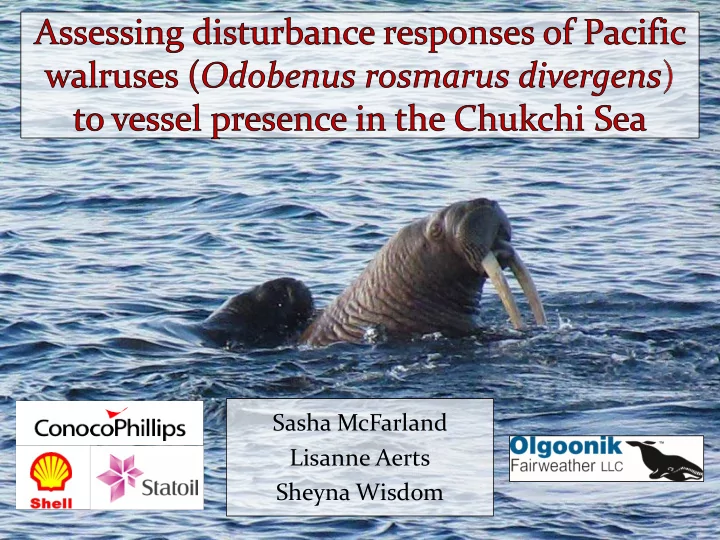

Sasha McFarland Lisanne Aerts Sheyna Wisdom
The Chukchi Sea • ~56% is shallower than 50 m • Covered by sea ice >8 months of the year, with partial coverage through the summer
Pacific Walrus in the Chukchi Sea • Pagophilic • Haulouts in AK – Calving – Sea ice – Protection – Transitioning to land locations – Transportation • 129,000 animals – Feeding – benthic
Potential Threats • Environmental • Anthropogenic – Sea ice retreat – Industry – Change in foraging – Science – Ocean acidification – Shipping – Recreational – Subsistence Strategic Stock
2013 Designation of Walrus Use Area • Temporal restrictions • ↑ reporting • 805 m buffer zone
Chukchi Sea Environmental Studies Program (CSESP) • Industry-funded science: • 2008-2014 (July-October) • Multi-disciplinary
2008-2013 Study Area KLONDIKE 2008-2013 BURGER 2008-2013 STATOIL 2010-2013 GREATER HANNA SHOAL 2011-2012
2014 Study Area
At what distances do we see disturbance responses to vessel presence?
Methods • Line transect surveys • 2 vessels • 2 observers • 2 hour shifts/12 hours a day • Observed to horizon, 180 ° in front of vessel • Reticles for distance • Effort data (weather, vessel) • Sighting data (species, pod composition/ numbers, behavior, movement, hauled out/in the water, and reaction)
Methods R/V Westward Wind R/V Norseman II
Methods
“Reaction” Coded as strongest observed • No = no observed reaction
“No”
“Reaction” Coded as strongest observed • No = no observed reaction • Look = looked at vessel
“Look”
“Reaction” Coded as strongest observed • No (NO) = no observed reaction • Look (LO) = looked at vessel • Change course/speed (CCS) = looked at vessel, then visibly accelerated or turned • Dive (DI) = looked at vessel, then rapidly dived
Data Analysis Linear Mixed Effects Models (AIC) • Response: Distance (log-transformed) • Fixed Effect: Reaction • Random Effects: – Year – Area – Beaufort sea state – Vessel – Water/Ice Tukey Contrasts for Multiple Comparisons of Means
Fixed Effects Sample Size Reaction n NO 376 LO 190 CCS 50 DI 96 TOTAL SIGHTINGS = 712
Random Effects Sample Size All random effects were included in the most parsimonious model Year n Area n Beaufort n Vessel n Water/Ice n 2009 20 Hanna 79 0-1 170 WW 630 Water 592 2010 51 Statoil 86 2-3 316 NII 82 Ice 120 2011 109 Burger 280 4-5 193 2012 280 Other 267 >5 33 2013 178 2014 74 TOTAL SIGHTINGS = 712
Differences in reaction types when compared by distance at which they occurred NO LO CCS LO <0.001 - - CCS <0.001 0.007 - DI <0.001 0.008 1 No significant difference between Change course or speed (CCS) and Dive
Reaction by Distance (m) 7000 6000 Sighting Distance (m) 5000 4000 3000 2000 1000 0 None Look Course/speedDive Reaction
Results: “None” 7000 • 75% of walruses that did not 6000 react were within ~2000 m of Sighting Distance (m) the vessel 5000 4000 • The middle 50% of walruses that did not react were 3000 between 300 and 2000 m away 2000 • The range of “no reaction” 1000 distances was ~0-4700 m, with 0 a few up to 7000 m away. None n=376
Zoomed reaction by Distance (m) 1000 Sighting Distance (m) 800 600 400 200 0 None Look Course/speedDive Reaction
Results: “Look” 1000 • 75% of walruses that looked at the vessel were within ~500 m of the Sighting Distance (m) 800 vessel • The middle 50% of walruses that 600 looked at the vessel were between 150 and 500 m away 400 • The range of distances at which walruses looked at the vessel was ~0-1000 m. 200 • Beyond 1000 m, no walruses looked at the vessel. 0 n=190 Look
Results: Change course/speed (CCS), Dive 1000 • 75% of walruses that Sighting Distance (m) CCS/dived were within ~300 800 m of the vessel • The middle 50% of walruses 600 that CCS/dived were between 75 and 300 m away 400 • The range of distances at which walruses CCS/dived 200 was ~0-600 m, with 7 exceptions (6 animals ~700 0 m, 1 animal ~1000 m). Course/speedDive n=146
Summary • Reactions differ by distance – There is no difference between CCS and DI – NO is different than LO and CCS/DI – LO is different than CCS/DI • Relative to current 805 m exclusion zone: – Only 7 sightings exhibiting CCS or DI reactions were >600 m from the vessel – 4 sightings exhibiting the LO reaction were >1,000 m from the vessel, all others within 1000 m • Design a specific disturbance study • Collaboration for publication
Data publically available www.chukchiscience.com Podcast: Chukchi Sea Environmental Studies Program: Research at the Edge of the World – Interviews with the scientists – website and iTunes
Thank you! • CSESP Colleagues • Captains and crew of WW, NII • Fairweather Science Colleagues • Community of Wainwright • Sponsors • Colleagues who assisted with analysis methodology
Recommend
More recommend